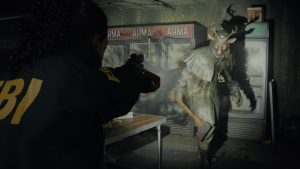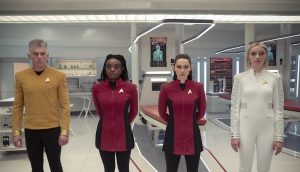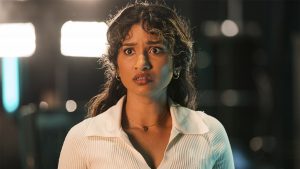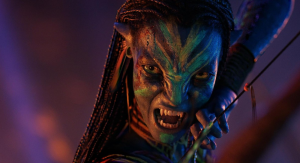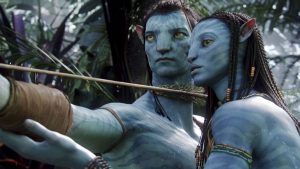
Ben Grimm is mad. The ace pilot would do almost anything for his college pal Dr. Reed Richards, the super-genius who has designed an experimental rocket. But Ben worries about cosmic rays surrounding the planet and threatens to drop out of the project.
“Ben, we’ve got to take that chance,” interjects friend Sue Storm. “Unless we want the Commies to beat us to it.”
With that Ben takes up the mission. Because if there’s one thing that Benjamin J. Grimm hates (beyond being called a coward, which Sue also does), its Commies. Well, at least that’s what Ben hated in the 1960s. And so he joins Reed, Sue, and Sue’s brother Johnny on a trip into space, a trip that will expose them to cosmic rays, transforming Ben into the Thing, Reed into Mr. Fantastic, Sue into Invisible Girl, and Johnny into the Human Torch. Together, they will form the Fantastic Four.
Fantastic Four #1 by Stan Lee and Jack Kirby — with inks by George Klein and Christopher Rule, colors by Stan Goldberg, and letters by Artie Simek — introduced the titular team and launched the Marvel Age of Comics. It’s a story that’s been told countless times in comics, movies, and television shows. It’s been updated to account for Marvel’s sliding timeline and transported to 17th century England and to the year 2099.
And yet, the origin has never worked better than it did in 1961, which makes speculation about the 2025 MCU film The Fantastic Four good news. In addition to confirming the film’s main cast — Pedro Pascal as Reed, Vanessa Kirby as Sue, Joseph Quinn as Johnny, and Ebon Moss-Bacharach as Ben — the announcement image suggested that the film takes place in the 1960s, down to the real issue of Life magazine that Ben is reading.
Although nearly every Fantastic Four adaptation has failed, great comic runs from John Byrne, Mark Waid and Mike Wieringo, and most recently, Ryan North demonstrate that the team need not stay in the 1960s. However, by starting in the 1960s, the MCU team can retain the origin and ethos essential to Marvel’s First Family.
The 1960s Origin of the Fantastic Four
On the most basic level, the ’60s setting makes the team’s origin more palatable. The origin story in Fantastic Four #1 has some outrageous elements, most notably Reed’s decision to include in the mission his young girlfriend Sue (not a scientist in Lee’s stories) and her even younger brother Johnny. Although writers Josh Friedman and Cameron Squires and director Matt Shakman will undoubtedly change some of those elements, the ’60s setting will allow them to keep the team’s central connection.
Even in the 1961 story, in which Ben complains about the threat of cosmic rays multiple times per page and immediately attacks Reed after his transformation into the Thing, the four members are bound by the fact that they choose to explore outer space. They didn’t act on behalf of anyone else, they weren’t motivated by external motivations. They made a choice and now they’re linked together forever.
To be sure, other versions of the FF origin have tried to keep that camaraderie. In their maligned script for 2015’s Fantastic Four, writers Jeremy Slater, Simon Kinberg, and Josh Trank (who also directed the movie) have Reed (Miles Teller), Sue (Kate Mara), Johnny (Michael B. Jordan), and Victor von Doom (Toby Kebbell) sneak into the lab to conduct their experiments in inter-dimensional travel, calling Ben as emotional support, to keep someone else from getting the credit.
But even beyond the clunky way Fantastic Four 2015 integrates Victor and Ben, the film makes the experiment part of a military operation. That change comes directly from the the first arc from Ultimate Fantastic Four (2004), by writers Brian Michael Bendis and Mark Millar, penciler Adam Kubert, inkers Danny Miki, colorist Dave Stewart, and letterer Chris Eliopoulos. In that story, Reed, Sue, and Johnny get recruited to participate in a military-sponsored think tank hosted at the Baxter Building. In the 2005 movie, written by Mark Frost and Michael France, Reed (Ioan Gruffudd) gets funding for a trip to study cosmic rays from maniacal CEO Victor von Doom (Julian McMahon).
All of these versions lack the simplicity of Lee and Kirby’s original story. The Fantastic Four of the comics risk their lives not for the vague scientific benefits that Gruffudd’s Richards rattles off in Fantastic Four 2005, nor under the orders of military leaders in other versions. They do it because they want to win the space race, a concern readily on the minds of American readers when Fantastic Four #1 hit newsstands in August 1961, mere months after Soviet Cosmonaut Yuri Gagarin made the first manned orbit around the planet. By setting the movie in the 1960s, the MCU Fantastic Four can make their reckless decision of their own accord and for something more tangible than general scientific advancement.
The 1960s Are Built into the Ethos of the Fantastic Four
Every Fantastic Four story, no matter the medium or setting, has involved the core bond between the central quartet. Even when not comprised of the founding four, the quartet is a family. Sometimes they squabble, sometimes they do terrible things to one another (see: Johnny’s love life or Reed during the Marvel Civil War), but the Fantastic Four always stay together in the end.
There’s something inherently optimistic in that fact, which is central to the ethos of the Fantastic Four. Although the ever-unreliable Stan Lee claimed that he created the Fantastic Four after his publisher/uncle-in-law Martin Goodman told him to try superheroes, hoping to replicate DC’s success with the Justice League of America, the FF didn’t start out as superheroes. Rather, they operated more as explorers in the vein of the Challengers of the Unknown or other scientists in the sci-fi and horror comics that Lee and Kirby made in the 1950s. The Fantastic Four took on codenames in the first issue, but they didn’t even get costumes until issue #3.
As explorers instead of superheroes, the Fantastic Four don’t really spend their time stopping threats or saving the day. They aren’t driven by the need to stand up for the innocent or to protect others. In fact, they aren’t driven by a relationship to evil at all. Instead, they believe that something wonderful, something fantastic, exists out there in the unknown. They believe that the pursuit of knowledge, encounters with different peoples and cultures, and mutual understanding will lead to progress. Sure, those beliefs often result in fist fights and laser battles that one expects in a Marvel comic, but that was never the driving force of these books.
Although Americans have had that spirit of hope in discovery before, it was never more pronounced than in the early ’60s in which the Fantastic Four were born. With the horrors of World War II and the destruction wrought by atomic weapons out of sight, and therefore out of mind, and a handsome young president in office, Americans thought they had a better world before them. Between John F. Kennedy’s aspirational speeches about hope and volunteerism and the wonders of the Space Race, Americans believed that the nuclear age would lead to better things.
Attempts to move the Fantastic Four’s origin out of the early ’60s have lost that sense of optimism. Most versions make the Four act out of response to some threat, whether it be an unexplained phenomenon heading toward Earth (1994 animated series), national defense concerns (Ultimate Fantastic Four and 2015 film), or Doom’s meddling (also part of the Ultimate origin, as well as the 2006 animated series Fantastic Four: World’s Greatest Heroes). Even the more lighthearted 2005 movie integrates the corporate baron version of Doom into the story, thus making the founding of the team more of a business deal than pure exploration.
The ’60s origin does position the team against Communists, but less as an existential threat and more of a rival (at least in Lee and Kirby’s telling). Thus, only the ’60s origin allows the tragedy of the Fantastic Four’s transformation come from a place of hope and wonder.
The MCU Needs the Fantastic Four Now More Than Ever
That sense of wonder couldn’t come at a better time for the MCU. The once-mighty franchise has fallen on hard times, with audiences no longer wowed by the Marvels of the shared universe. There’s a feeling that we’ve seen much of this stuff before and that Marvel Studios is starting to repeat itself.
Things have gone bad in-universe, too. Founding heroes Iron Man, Captain America, Scarlet Witch, and Black Panther have all died, some replaced by new versions and others leaving an unfilled gap in the Avengers lineup. Earth’s Mightiest Heroes are no more in current continuity, while CIA director Valentina Allegra de Fontaine assembles her own team of anti-heroes. These anti-heroes will make their debut in Thunderbolts, scheduled to release two months before Fantastic Four hits theaters.
Bringing in the Fantastic Four sooner rather than later means the MCU gets four of the biggest A-listers in Marvel history to fill the void by other big-name heroes. They also bring a much needed breath of hope and optimism to the MCU. No, it won’t be all sunshine and roses. Even in the ’60s, Fantastic Four stories focused on the despair that Ben felt after becoming the monstrous Thing and Reed’s guilt for the part he played. Furthermore, the first official picture for Fantastic Four hints at the fading of the ‘spirit’s ’60s good spirits, as the Thing is reading the December 13, 1963 issue of Life Magazine, commemorating the start of Lyndon Johnson’s presidency after the Kennedy assassination. Furthermore, if the Fantastic Four come to Earth-616 of the MCU because their world was consumed by Galactus (rumored to be the villain of the film), then they’ll have some heaviness in their hearts.
But the FF have faced hardship before and they’ve always gotten through it together. They persevere because of their familial bond and their hope for the futures, both qualities given to them in their very first story from 1961.
The post Fantastic Four: Why the 1960s Setting Is a Perfect Choice for the New Movie appeared first on Den of Geek.
